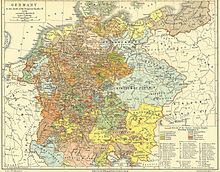Interregnum (Holy Roman Empire)
This policy met some resistance in 1274 when a Diet held in Nuremberg decreed that the Count Palatine of the Rhine would be the judge in such cases, diluting some of Rudolf’s power.Rudolf was frustrated in his attempts to gain control of Babenberger lands in modern-day Austria as his base of support rested on appearing as non-threatening to the other princes.Adolf utilized funds from England meant to finance a war with France to instead gain control of Thuringia, which was desired by the electors and other princes due to inheritance disputes.The Luxembourgs were an up and coming family in German politics and Henry found himself in the same position as Adolf of Nassau, having to concede several powers to the princes in order to be elected.This combined with his public renunciation of Thuringian claims got him support from the princes to enfeoff Bohemia to his son John, securing a royal title for his family.The Luxembourgs and Habsburgs held a similar level of influence due to a gradual collection of territory, so Henry's son John put Louis of Wittelsbach forward as an imperial candidate.[4] Charles can be seen as an end to the Interregnum, having possession of the title of emperor, holding it for several decades, passing it on to his son Sigismund and having no serious anti-king threat to his reign.Charles' actions in his reign also saw a modest revival of imperial interest in Italy[8] and shifted the center of German politics from central and southern Germany towards the east at Bohemia, and later Austria.


Holy Roman EmpireFrederick IIHohenstaufenKing of the RomansCharles IV of LuxembourgemperorWenceslausprince-electorsCrusade against the HohenstaufenConrad IVWilliam of HollandRichard of CornwallAlfonso X of CastileOttokar IIRudolf of HabsburgBabenbergerAustriaAdolf of NassauAlbertJohannHenry of LuxembourgFrederick of HabsburgLouis of WittelsbachCharlesGolden Bull of 1356SigismundInvestiture CrisisInnocent IVJohn XXIIRhenseClement VIBalduineumcommunal movementsSwabian League of CitiesHanseatic LeagueSwiss ConfederacyfeudingThuringian Counts' Warrobber baronsjusticeKleinstaatereinational unificationCount-kingsCrisis of the Late Middle AgesFeudalism in the Holy Roman EmpireFormation of the Old Swiss ConfederacyGuelphs and GhibellinesImperial immediacyInterrexList of German monarchsMedieval communePrince-electorStädtebundTranslatio imperiiWestern SchismLexikon des MittelaltersMonumenta Germaniae HistoricaHistorical Dictionary of Switzerland